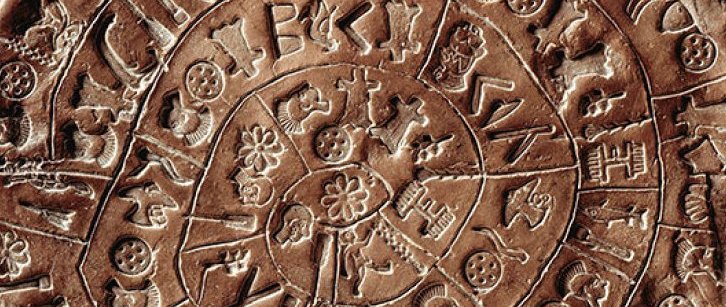The Phaistos Disk, dating to around 1700-1600 BC and on display at the archaeological museum of Heraklion, is one of the most controversial inscriptions in the history of mankind. Much has been written about it, but there is still much more to be learnt before its mystery can be fully understood. Chronologically, it belongs to the period of Minoan Writing, but differs in many ways from it. The writing on the disc was inscribed in the clay using different stamps and is believed to be the oldest global form, about 2,500 years before the first samples of printed materials.
The disc was discovered in 1908 by the Italian archaeologist Luigi Pernier in the Minoan palace-site of Phaistos on the island of Crete. It has become a symbol of Crete, a major draw to Heraklion, and the logo of the Foundation for Research and Technology – Hellas (FORTH), one of the largest research centres in Greece.
 The National Documentation Centre and the Technological Educational Institute of Crete are holding an event on Wednesday 7 February 2018 (17.30) at the National Hellenic Research Foundation which will ‘reveal’ the secrets of the Disc of Phaistos based on the results of recent scientific research.
The National Documentation Centre and the Technological Educational Institute of Crete are holding an event on Wednesday 7 February 2018 (17.30) at the National Hellenic Research Foundation which will ‘reveal’ the secrets of the Disc of Phaistos based on the results of recent scientific research.
Dr. Gareth Owens, an expert on Minoan script, has dedicated 10 years of research to the disc. Working with John Coleman, Professor of Phonetics at Oxford University, they are now able to ‘read’ 99% of the inscriptions. As a result of this research, Dr. Owens can now provide us with a documented, detailed and reliable interpretation to ‘reveal’ the secrets of the Disc of Phaistos. With respect to history and aware of the weight of the undertaking, he takes the research into interpretation of the disc a step further, talking about its essence and giving us what might be the ‘key’ to entering the sanctuary of the Minoan world. He has recently claimed that the Phaistos Disc is indeed a religious text written in the Minoan Language. Using as a reference the decipherment of Linear B by Michael Ventris, he believes that hh can ‘read’ the signs on the Phaistos Disk, using sound values from Mycenaean Linear B (via Minoan Linear A and Minoan “Cretan Hieroglyphics”).
The Disc of Phaistos, with a diameter of roughly 16 cms, is inscribed on both sides with a total of 242 tokens, divided into 61 groups. There are 45 distinct signs on the disc, more than necessary for an alphabet but fewer than necessary for a true ideographic script, as is the case with Chinese. This observation enables us to deduce that it is also a syllabic script, as are both Linear B and Linear A.
Read more: Technological Educational Institute of Crete website – “From Linear B to the Phaistos Disk”; Gareth Owens’ audio interpretation of the disk: Minoan App – The voice of the Phaistos Disc; Decrypting the Phaistos Disk: Gareth Owens at TEDxHeraklion
N.N.















